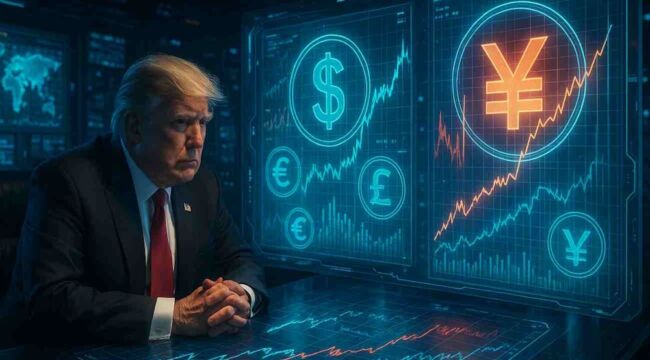Trump Drafts the Fed Into Currency Wars
Last week President Trump made a big move in the currency wars.
He appointed Stephen Miran, head of the White House Council of Economic Advisers, to a vacated seat on the Fed’s Board of Governors.
I’m going to pull together some important threads. I’ll also speculate about what Trump’s plans for remaking the Fed might mean for international trade, and how Miran can assist.
This could translate into an acceleration of the bull market in gold, currency, mining, and energy. In these areas, we are confident we’re far ahead of the human and algorithmic trading crowd, who are still piled into overstretched Big Tech and AI trades.
First, I’ll set the stage.
Currency wars, the theme of Jim’s first best-selling book, are policy actions that a country takes to devalue its currency.
The intent is to subsidize local exporters by allowing them to price goods at a cheaper level than competitors when adjusting for exchange rates.
Other countries typically shoot back against the first shot by devaluing their own currencies.
Asian economies have done this for decades while the U.S. unilaterally disarmed – mostly on whispered orders from Wall Street and its political lobbyists.
Cementing the U.S. dollar into place as the dominant transaction and reserve currency has been the key ingredient in hollowing out our manufacturing sector, removing spending discipline from Congress, and super-sizing the financial sector to a politically volatile degree. All these things relate to the dollar’s role as a perceived store of value.
Currency battles can escalate into a war where, in the end, all currencies devalue against gold. Gold is the historical (and possibly future) money for settling international trade.
China-U.S. trade is the most important global trade relationship by far.
To avoid crippling tariffs and a Chinese currency devaluation that would reinforce the old currency war paradigm, China might agree with a hypothetical currency clause in a trade deal with Trump.
Such a clause could chart a path back to settling international trade imbalances in gold. This clause would solve several problems at the center of the trade imbalances that Trump (and most Americans) dislike:
- From the trade surplus country perspective: Settling trade in gold would be a way to force a lasting truce in currency wars. China could rebuild local confidence in its fragile financial system and minimize the risk of a deflationary debt crisis by being more explicit about the role of gold as a store of value. Other large trade surplus countries like Japan, Korea, and Germany might gain more fiscal room to deal with their inevitable aging demographic challenges by devaluing against gold.
- From the trade deficit country perspective: The U.S. paying for Chinese imports in gold would reassure China that it’s receiving real money – real savings, not printed savings – for goods. Gold is money that cannot be devalued. As the dollar is devalued against gold, it would also boost the price of imports (in U.S. dollar terms) to such a degree that U.S. consumers would heavily favor locally made U.S. products. This hypothetical devaluation of the dollar against gold would also give the U.S. more fiscal breathing room and lessen the risk of a debt crisis from the leverage that’s built up in this credit cycle. Credit excesses in this cycle are large, but well-hidden. They include private equity, FHA mortgages that are rapidly going delinquent, soon-to-be-collected student loans, and “buy now, pay later” loans.
It’s possible to imagine a world where existing paper currencies dominate local trade relationships within countries, while gold dominates trade settlement internationally.
After all, China has been quietly accumulating gold for decades to prepare for this possibility.
American Birthright: Locally Produced Goods, Gold, Metals, and Oil
Here’s how the currency war theme relates to our American Birthright theme…
Trade policy and currency policy are more effective when they are aligned. One without the other is like boxing with one hand behind your back.
Trump recognizes this. He is eager to exert more control over the Fed because without the Fed’s help, the substance of Trump’s trade realignment goals would fall short of expectations.
Our American Birthright theme – maximizing local production of energy and minerals – won’t just provide the raw materials needed to reshore industries that were outsourced to China.
It could also boost production and jobs. It could crimp the torrent of U.S. dollars that have been flowing overseas for decades – dollars that blow financial bubbles when they are reinvested on Wall Street.
Bubbles widen our politically dangerous wealth gap by boosting the U.S. dollar, asset prices, and costs of production.
Bubbles also work to make our manufacturing sector uncompetitive globally because they incentivize too many stock buybacks at the expense of less-certain – but more jobs-oriented – R&D and capital projects.
Finally, bubbles also divert public attention from real-world investments that can benefit living standards. Instead, they focus attention on pump-and-dump operations, which are more widespread than you might suspect.
To keep inflating, bubbles require an endless supply of “greater fools.” The last ones in line wind up being bag holders. And when the supply of greater fools ends, perceived paper wealth vanishes.
Reading between the lines of Stephen Miran’s paper, he understands how damaging bubbles can be to economic sustainability.
The Miran Move To The Fed
Last week, Trump made a big move to draft the Fed into currency war duty.
The move could even be a stepping stone to nominating Miran as Chairman when Jay Powell’s term ends in May 2026. It may be an audition for a bigger job. Trump often surprises people with personal decisions.
Even if Trump chooses another nominee to replace Powell, the pattern is clear: The Fed will be drafted to serve in a long-overdue rebalancing of trade flows.
Moving from his role as White House Council of Economic Advisers chair to the Fed’s policy-making core, Miran will bring a radical perspective to FOMC meetings: He understands that the dollar’s reserve currency status has transformed from “exorbitant privilege” to “exorbitant burden.” We know this from Miran’s public papers, speeches, and interviews.
Most Fed appointments involve seasoned academics or financial industry veterans who respect the established monetary orthodoxy. This orthodoxy needs a radical overhaul.
Miran’s Dollar Trap Theory
Miran’s analysis centers on what economists call the Triffin Dilemma. As the world’s reserve currency, the dollar must satisfy global demand for transactions and savings. This creates persistent U.S. trade deficits – not through American profligacy, but through structural necessity.
Under the status quo, the world demands U.S. dollars to function. Americans must supply them by importing more than they export. This keeps the dollar artificially strong, making U.S. manufacturing less competitive while foreign producers gain currency war advantages.
Previous Fed governors treated this as an immutable fact of international finance. Miran sees it as a solvable problem. But it requires coordinated action between fiscal and monetary policy.
Currency Maneuvers as Economic Warfare
Where previous administrations offered diplomatic protests against currency manipulation, Miran advocates using tariffs as strategic leverage. His approach treats exchange rates not as market outcomes, but as policy tools that can be adjusted through coordinated pressure.
Here is Miran’s key insight from his November 2024 paper, A User’s Guide to Restructuring the Global Trading System: tariffs alone often fail because currency devaluation can offset their effects.
A 25% tariff becomes meaningless if the targeted country’s currency weakens by 25%.
Miran’s solution involves sequencing. He proposes using tariffs to create negotiating pressure, then coordinating currency adjustments to ensure the intended economic effects actually occur.
We certainly saw high tariffs being used as negotiating pressure on Liberation Day, April 2.
This reflects how modern trade wars actually function. Most policy makers focus on individual tools such as tariffs, or currency policy, or trade negotiations in isolation.
Miran recognizes they must work together or they will work against each other.
Why This Appointment Matters
Despite his bold vision, Miran is aware of implementation risks. His paper emphasizes “gradualism” and careful sequencing to avoid financial market chaos.
“There is a path by which these policies can be implemented without material adverse consequences,” Miran noted, “but it is narrow, and will require currency offset for tariffs and either gradualism or coordination with allies or the Federal Reserve on the dollar.”
Previous Fed appointments operated within established parameters of central banking habits. Fed officials have left currency policy to the Treasury Department.
Miran’s appointment cuts through this institutional separation. For the first time in decades, someone sits on the Fed board who views currency intervention as a core central banking responsibility rather than an emergency exception.
Market Implications
Currency traders and international investors face a new reality: the Federal Reserve may no longer act as a passive observer of exchange rate movements. If Miran’s views influence Fed policy, currency markets could become an active battlefield rather than a neutral pricing mechanism.
The implications extend beyond foreign exchange. Bond markets, stock markets, and commodity markets all depend on assumptions about central bank behavior. A Fed that actively manages the dollar’s exchange rate operates under entirely different parameters than one focused solely on domestic inflation and jobs.
A Fed drafted into currency wars – with the potential for a gold-settlement peace treaty – means the following:
- less “forward guidance” of interest rates to comfort bond traders;
- less outdated Keynesian economy-as-factory models – the models that utterly failed to anticipate the worst inflation in decades in 2021;
- more recognition that the dollar as a reserve currency has the costly tradeoffs of de-industrialization, trade imbalances, fiscal incontinence, and wealth divides.
- What All This Means For Our Portfolio
As President Trump works to alter global trade deals, driving a harder bargain for the American worker, we’ll see higher currency and stock market volatility. We may even see a technical recession (with Trump getting the substantial rate cuts that he’s been pressuring the Fed to make).
If economic rivals respond to tariffs and Fed rate cuts by devaluing currencies, then investors around the world have yet another reason to own gold as insurance against monetary instability.
We still see plenty of opportunity to profit from well-placed companies in the natural resources sector.



Comments: